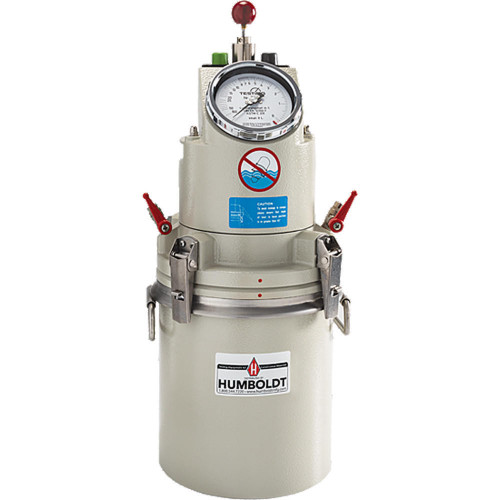Fast
Shipping
Quick,
Simple Ordering
Clear,
Upfront Pricing
Over 30,000
Happy Customers
Exceptional
Customer Service
Industry's Largest
Catalog
Humboldt H-2847, Air Entrainment Meter for Mortar, 0.5L
Air entrainment meters for testing freshly-mixed mortar with direct readings in percent. Uses hand-operated pump.
The H-2845 and H-2846 Air Meters are used for the determination of the total air content in cement paste, mortar and masonry cement. These meters have a pressure chamber, in which a defined pressure is generated. By opening the overflow valve, the pressure in the chamber is equalized within the sample container, which is filled with mortar. The pressure drop is a measurement of the air content present in the mortar. The accuracy of the pressure gauge is 1.0.
Both air meters use pushbutton controls for simple test operation. Both meters use a mechanical valve to provide a reliable seal between the pressure chamber and test container. The pressure gauge is integrated in the top of the meter. Quick-release fasteners between the container and cover provide easy sealing and opening of the meter.
Both meters utilize a robust hand pump for operation independent of air supply system.
H-2845: 1 liter volume — EN 1015-7 and EN 459-2
H-2846: 0.75 liter volume — EN 413-2
Line Scale of Pressure Gauge
0-5% by volume 0.1% by volume per scale division
5-10% by volume 0.2% by volume per scale division
10-20% by volume 0.5% by volume per scale division
20-30% by volume 1.0% by volume per scale division
30-50% by volume 5.0% by volume per scale division
50-100% by volume without scale division
Browse Certified MTP for all of your cement test equipment needs like cube molds for concrete, cement, mortar, and grout.
Air entrainment meters are essential tools used in cement testing to measure the amount of air trapped within mortar samples. Air entrainment refers to the intentional incorporation of small air bubbles in mortar or concrete to enhance its durability and workability. These meters provide accurate and reliable measurements, allowing for quality control and assurance in construction projects.
Air entrainment meters typically consist of a cylindrical container, a pressure gauge, and a pressure pump. The process begins by filling the container with a known volume of mortar sample. The pressure pump is then used to apply pressure to the sample, causing the air bubbles to be released and rise to the surface. The pressure gauge measures the pressure required to release the air bubbles, which is a direct indication of the amount of air entrained in the mortar.
The results obtained from air entrainment meters are expressed as the percentage of air content in the mortar. This measurement is crucial as it affects the workability, freeze-thaw resistance, and overall durability of the concrete or mortar. Different construction applications require specific air content ranges, and these meters help ensure that the mortar meets the desired specifications.
Air entrainment meters are designed to provide accurate and repeatable results. They are calibrated regularly to maintain their precision. Furthermore, they are portable and easy to use, making them suitable for both laboratory and field applications.
In summary, air entrainment meters are valuable tools in cement testing, allowing engineers and technicians to measure and control the air content in mortar accurately. By ensuring the desired air entrainment levels, these meters contribute to the durability, workability, and performance of concrete in various construction projects.



